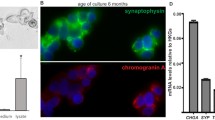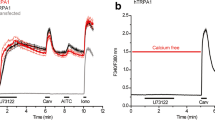Abstract
Pretreatment of isolated mast cells with analogs of neurotensin 8–13 (NT8–13), in which the amino acids Leu13 or Ile12 are replaced with an aspartic acid (Asp13-NT8–13 or Asp12-NT8–13), inhibits the secretion of histamine in response to NT. A 10 min pretreatment with either analog (10 μM) inhibited NT-induced histamine release by 90% (Asp13-NT8–13) or by 98% (Asp12-NT8–13). At concentrations that are inhibitory, Asp13-NT8–13 and Asp12-NT8–13 alone elicit very little release (<5% at 10 μM). In the continued presence of the analogs, the inhibitory effect lasts for more than 45 min; removal of the analogs resulted in restoration of sensitivity to NT within 10 min. Pretreatment with analog Asp13-NT8–13 resulted in a 39% inhibition of stimulation by substance P and a 52% inhibition of stimulation by histaminereleasing peptide (HRP). In contrast, pretreatment with analog Asp12-NT8–13 gave no inhibition of release by SP or HRP. Neither analog inhibited histamine release in response to bradykinin (BK), NT1–12, compound 48/80 (48/80), the calcium ionophore A23187, or anti-IgE stimulation of passively sensitized mast cells. Although Asp12-NT8–13 and Asp13-NT8–13 differ slightly in regard to the peptides they inhibit, both probably act at a step early in the stimulus-secretion coupling sequence; most likely before the rise in the level of free intracellular calcium that has been shown to accompany secretion in mast cells. It is suggested that these analogs exert their inhibitory effect on NT by competing with NT for a binding site on the mast cell membrane. The limited number of peptides inhibited by these analogs suggest that not all basic peptides act at the same site to stimulate secretion.
Similar content being viewed by others
References
M. H. Fernstrom, R. E. Carraway and S. E. Leeman,Neurotensin. InFrontiers in Neuroendocrinology Vol. 6 (Ed. L. Martini) pp. 103–127, Raven, New York 1980.
S. A. St. Pierre, E. Kerouac, R. Quirion, F. B. Jolicoeur and F. Rioux,Neurotensin. InPeptide and Protein Reviews Vol. 2 (Ed. M. T. W. Hearn) pp. 83–171, Marcel Dekker, New York 1984.
R. E. Carraway and S. E. Leeman,The isolation of a new hypothalamic peptide, neurotensin, from bovine hypothalamus. J. Biol. Chem.248, 6854–6861 (1973).
S. E. Leeman and R. E. Carraway,Neurotensin discovery, isolation, characterization, synthesis and possible physiological roles. Ann. N.Y. Acad., Sci.400, 1–16 (1982).
R. E. Carraway, D. E. Cochrane, J. B. Lansman, S. E. Leeman, B. M. Paterson and H. J. Welch,Neurotensin stimulates exocytotic histamine secretion from rat mast cells and elevates plasma histamine levels. J. Physiol.323, 403–414 (1982).
R. E. Carraway, D. E. Cochrane, R. Salmonsen, K. Muraki and W. Boucher,Neurotensin elevates hematocrit and plasma levels of leukotrienes, LTB4, LTC4, LTD4 and LTE4, in anesthetized rats Peptides12, 1105–1111 (1991).
D. E. Cochrane, C. Emigh, G. Levine, R. E. Carraway and S. E. Leeman,Neurotensin alters cutaneous vascular permeability and stimulates histamine release from isolated skin. Ann. N.Y. Acad. Sci.400, 396–397 (1982).
D. E. Cochrane, W. Boucher and P. Bibb,Neurotensin stimulates histamine release in in vivo skin “blisters” in rats: An effect inhibited by cromolyn or somatostatin. Int. Arch. Allergy Appl. Immunol.80, 225–230 (1986).
R. Sagi-Eisenberg, Z. Ben-Neriah, I. Pecht, S. Terry and S. Blumberg,Structure-activity relationship in the mast cell degranulating capacity of neurotensin fragments. Neuropharmacol.22, 197–201 (1983).
P. Kitabgi, F. Checler, J. Mazella and J. P. Vincent,Pharmacology and biochemistry of neurotensin receptors. Rev. Clin. Basic Pharmacol.5, 397–486 (1985).
D. E. Cochrane, R. E. Carraway, W. S. Boucher and R. S. Feldberg,Rapid degradation of neurotensin by stimulated mast cells. Peptides12, 1187–1194 (1991).
H. Shibata, M. Mio and K. Tasaka,Analysis of the mechanism of histamine release induced by substance P. Biochem. Biophys. Acta846, 1–7 (1985).
H. Repke and M. Bienert,Structural requirements for mast cell triggering by substance P-like peptides. Agents and Actions23, 207–210 (1988).
L. A. Miller, W. S. Boucher, D. E. Cochrane and R. E. Carraway,Inhibitory effect of the neurotensin analog Asp 13-NT 8–13 on mast cell stimulation. J. Cell Biol.111, 338a (1990).
D. E. Cochrane and W. W. Douglas,Calcium-induced extrusion of secretory granules exocytosis in mast cells exposed to 48/80 or the ionophores A23187 and X-537A. Proc. Natl. Acad. Sci. USA71, 408–412 (1974).
P. C. Bibb, D. E. Cochrane and N. Morel-Laurens,Loss of quin 2 accompanies degranulation of mast cells. FEBS Lett.209, 169–174 (1986).
D. E. Cochrane, W. W. Douglas, T. Mouri and Y. NagazatoCalcium and stimulus-secretion coupling in the adrenal medulla: Contrasting stimulating effects of the ionophores X-537A and A23187 on catecholamine output. J. Physiol.252, 263–278 (1975).
D. E. Cochrane, D. L. Distel, J. B. Lansman and B. M. Paterson,Stimulus-secretion coupling in rat mast cells: Inactivation of extracellular calcium dependent secretion. J. Physiol.323, 423–435 (1982).
B.R. Rosengard, C. Mahalik and D. E. Cochrane,Mast cell secretion: Differences between immunologic and nonimmunologic stimulation. Agents and Actions19, 133–140 (1986).
J. L. Bueb, M. Mousli, Y. Landry and C. Bronner,A pertussis toxin-sensitive G protein is required to induce histamine release from rat peritoneal mast cells by bradykinin. Agents and Actions30, 98–101 (1990).
T. Ishizaka and K. Ishizaka,Activation of mast cells for mediators release through IgE receptors. Prog. Allergy34, 188–235 (1984).
H. F. Saito, T. F. P. Molski, R. I. Sha'afi and T. Ishizaka,Effects of ADP-ribosylation of GTP-binding protein by pertussis toxin on immunoglobulin E-dependent and independent histamine release from mast cells and basophils. J. Immunol.138, 3927–3943 (1987).
M. Aridor, L. M. Traub and R. Sagi-Eisenberg,Exocytosis in mast cells by basic secretagogues: Evidence for direct activation of GTP-binding proteins. J. Cell Biol.111, 909–917 (1990).
P. C. Bibb and D. E. Cochrane,Replenishment of the cellular calcium required for non-immunologic stimulation of mast cell histamine secretion: Temperature sensitivity and inhibition by manganese and sodium-free conditions. Agents and Actions25, 27–36 (1988).
J. L. Bueb, M. Mousli, C. Bronner, B. Rouot and Y. Landry,Activation of a G i -like proteins, a receptor independent effect of kinins in mast cells. Mol. Pharmacol.38, 816–822 (1990).
Author information
Authors and Affiliations
Rights and permissions
About this article
Cite this article
Miller, L.A., Cochrane, D.E., Carraway, R.E. et al. Inhibitory effects of the neurotensin8–13 analogs Asp13-NT8–13 and Asp12-NT8–13 on mast cell secretion. Agents and Actions 38 (Suppl 1), 1–7 (1993). https://doi.org/10.1007/BF02027206
Issue Date:
DOI: https://doi.org/10.1007/BF02027206




